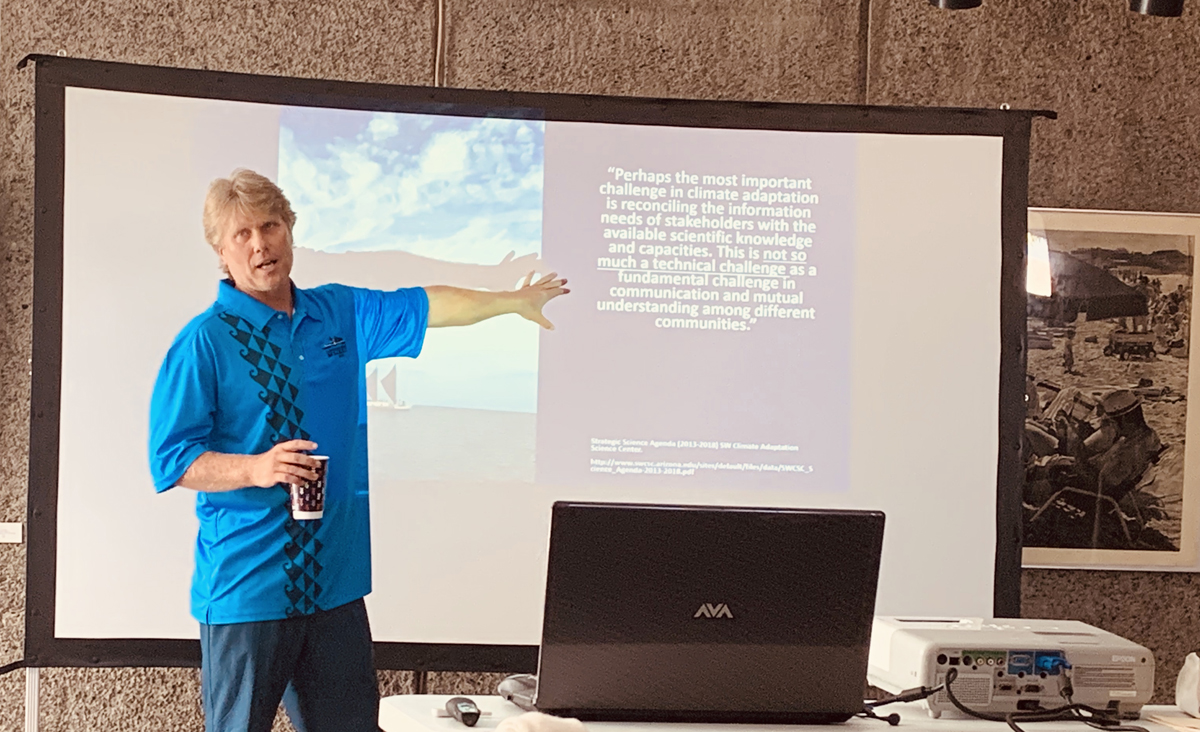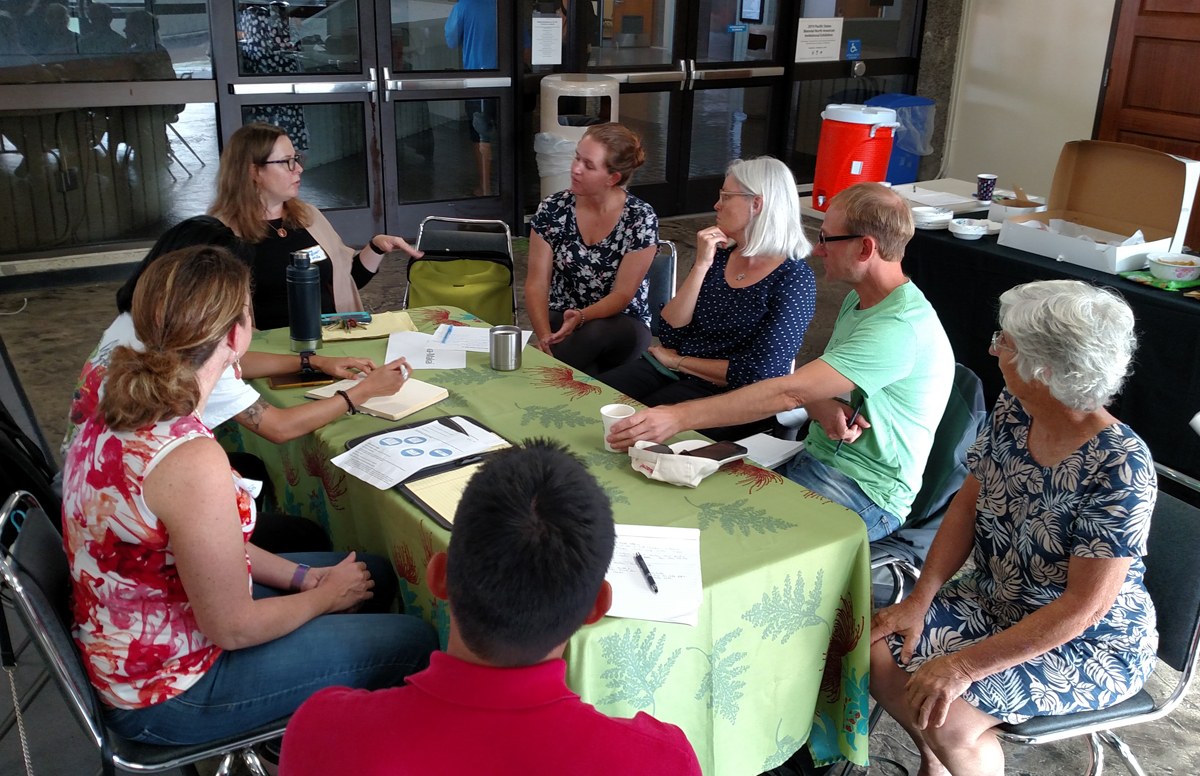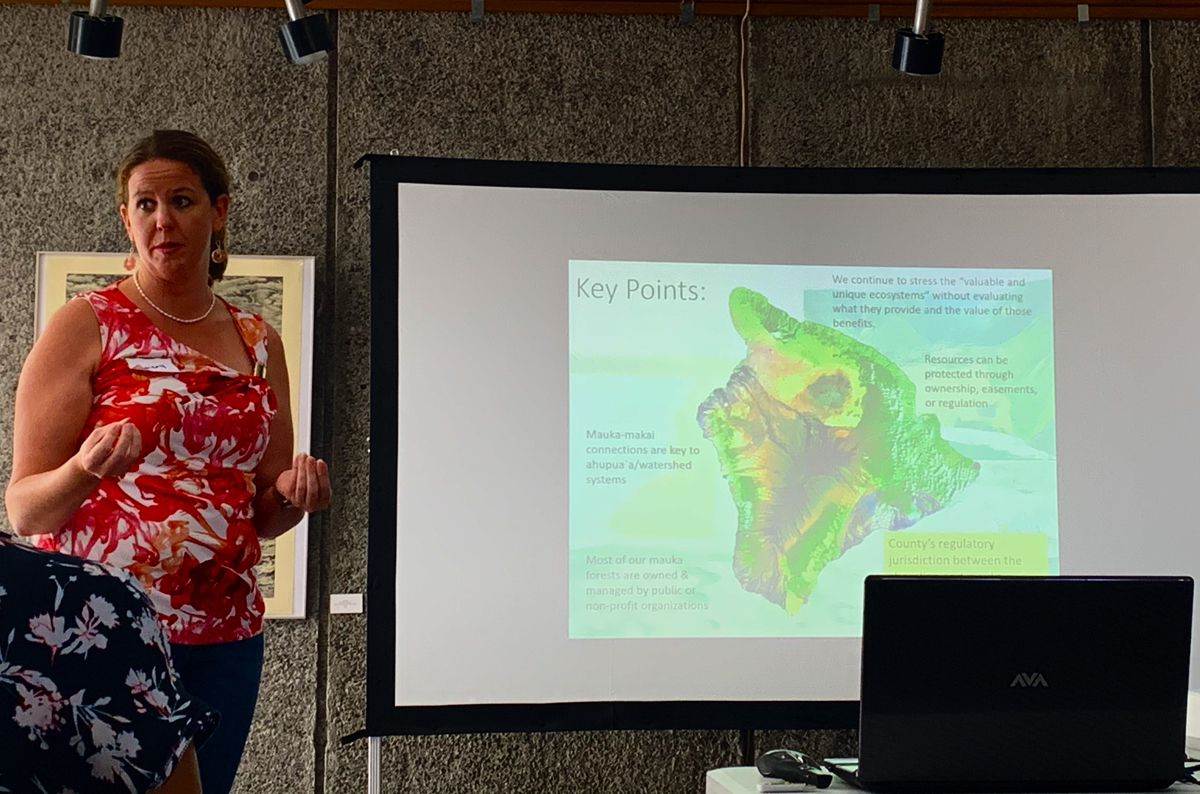Manager Climate Corps Gathers Hawai‘i Island Networks
Adaptation to climate change is no simple task, and many times managers do not have the time to seek out researchers and resources to answer their management questions surrounding how best to maintain resilient ecosystems and communities. For managers to adapt effectively, they need to know what information is available, which methods may best apply to their challenges, and what pathways they can use to achieve their adaptation goals. So, PI-CASC University of Hawai‘i at Hilo (UH Hilo) Consortium Lead Sharon Ziegler-Chong and Program Specialist Scott Laursen developed and launched the Manager Climate Corps (MCC) Program in January 2016 to facilitate this relationship-building between researchers and local resource managers. More recently, on November 20th, 2019, the PI-CASC hosted an MCC meeting at UH Hilo to continue supporting these important discussions.
Similar to the inaugural 2016 meeting, this gathering was geared towards facilitating discussions around managers’ needs and how those needs could be met through resource and research networks. Results from this meeting will continue to fuel the MCC’s goal of supporting long-term partnerships between local manager networks, UH faculty, the US Geological Survey, and the PI-CASC. This is especially relevant, as the PI-CASC will be requesting Statements of Interest from the community for the MCC program in early 2020 with a goal of developing a new cohort of two-year manager-driven research projects by the fall of 2020 at UH Hilo.


Participation in these new discussions was robust, with a room full of students, researchers, faculty, and community members interested in climate adaptation collaboration, co-production, and opportunities for funding on Hawai‘i Island. Sharon and Scott welcomed everyone and told the story of MCC’s unique approach, stressing the need for multiple knowledge forms, collaborative local networks, trust, and knowledge co-production. (Read more at the MCC website.) This prepared the participants to think critically of ways to meet climate adaptation needs using the MCC approach.
The afternoon was filled with rich presentations by local resource managers from the Mauna Kea Watershed Alliance, Hawai‘i Department of Hawaiian Homelands, Hawai‘i County Planning, Ala Kahakai National Historic Trail (National Park Service), South Kohala Coastal Partnership, Hawai‘i Division of Aquatic Resources (Dept. of Land and Natural Resources), and Conservation International. With an eye to the broader context for adaptation across the island, talks were arranged topically from mauka (towards mountain) to makai (towards ocean), starting concerns from the peaks of Maunakea and moving down to the needs of nearshore reefs. As the talks shifted down the ahupua‘a (traditional Hawaiian land division), participants saw a host of opportunities for where they could plug in for potential collaborations.
The presentations spotlighted an incredible diversity of research needs and how those needs tie into each organization’s mission. This was clearly shown by Maunakea land managers, Cheyenne Perry with the Mauna Kea Watershed Alliance and Kuali‘i Camara with the Department of Hawaiian Homelands. The Watershed Alliance focuses on the protection of high elevation forested watersheds, and thus prioritize wildfire management, disease resistance testing for rapid ‘ōhi‘a death, and increased GIS analysis capacity. Meanwhile, Hawaiian Homelands has a mandate to enhance and restore landscapes for the betterment of the Hawaiian people. This goal generates a much broader spectrum of research needs from understanding ecology to exploring the impacts of restoration, developing circular economies, and studying the effects of social change.


Moving into the human habitation zone, Bethany Morrison from the County of Hawai‘i Planning Department, showed how their dedication to public health, safety, and overall quality of life produced a drive to integrate the 3.2-foot sea level rise exposure area into all county plans, including development of any setback codes for streams, wetlands, and anchialine ponds. Folks from the South Kohala Coastal Partnership and the Ala Kahakai National Historic Trail highlighted their joint need for a full island inventory and management decision tool for anchialine ponds, as these are unique coastal ecosystems facing an uncertain future. A strong member of this partnership, the Kailapa community, seeks to inventory all biological resources along their shoreline to inform community-driven resilience planning. (Read their community resilience plan at their website.)
Finally at the ocean, the Division of Aquatic Resources described a large assortment of research needs, from analyses on climate change impacts to fish life-history traits, anchialine pond habitat health, estuarine health, and stream behavior. Troy Sakihara from the Hilo office asked for specific help in developing rapid bio-assessments of stream health and effective sampling methods of juvenile estuary fish. Lastly, Ulu Ching from Conservation International closed by illustrating the effectiveness of the MCC process to generate meaningful and lasting results by highlighting the recently finished MCC project on the ‘ōpelu fishing communities of Ho‘okena and Miloli‘i, Kona. (Read more on the project page at the MCC website.)
After the presentations, participants joined one of four breakout groups, arranged topically from mauka to makai, with the intention of sharing knowledge and building new relationships. Each group had dynamic roundtable discussions that pulled in individual expertise and experiences to address each agency’s unique set of challenges and research needs. PI-CASC director Mari-Vaughn Johnson and communications intern Darcy Yogi joined the “Mauka-Makai” group, which spanned issues across the full landscape. The discussion was productive, with topics from erosion management methods in gulches to agricultural riparian buffer examples, and ideas for both vertical and horizontal county setbacks. Overall, participants came to the tables with networks, projects, students, alternatives, funding ideas, and perspectives, all in effort to help steward our island home.
For more on MCC, please visit the MCC website. Check out other interesting stories on MCC manager-driven research projects though the UH Hilo Stories website, where you can read all about their students’ recently completed projects on near-shore water quality, fishpond management and restoration, coastal erosion monitoring and planning, and agricultural solutions to invasive albizia trees.

